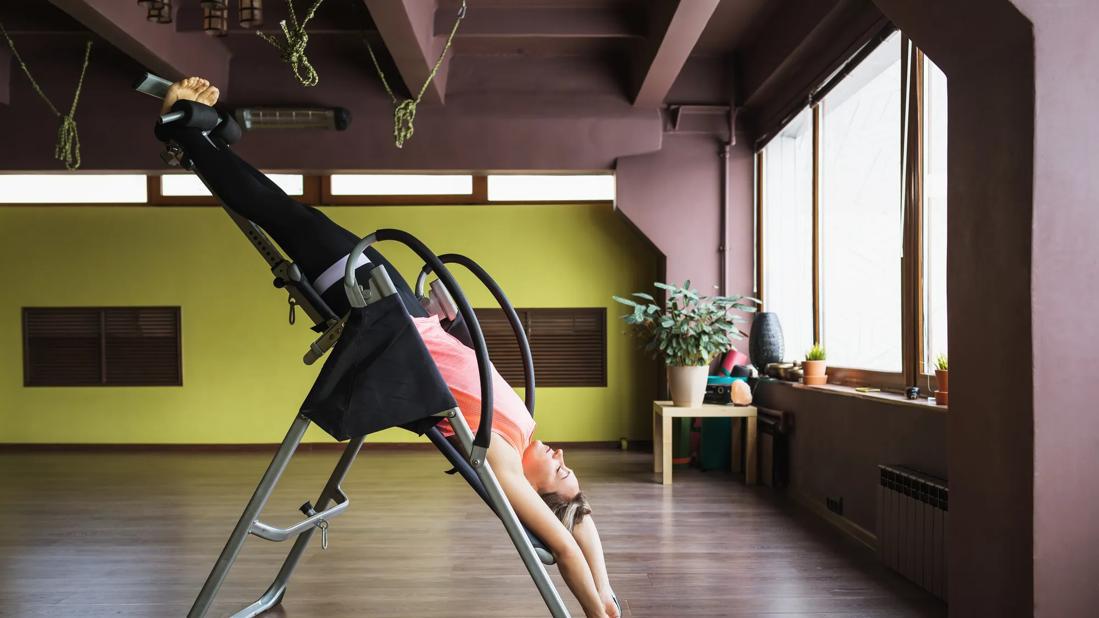Inversion Tables Might Flip the Script on Back Pain
Hanging upside down for any length of time may decompress the tension in your spine

Inversion tables — which suspend you upside down — are said to relieve back pain by taking pressure off your spine. Whether or not they work is another question.
Pain management specialist Haren Bodepudi, MD, explains what the science says and what you should know before you fall heels-over-head in the name of pain relief.
What is inversion therapy?
Inversion therapy, also known as spinal traction, is a spinal decompression technique that involves hanging upside down, usually with the help of an inversion table or chair. The theory behind it is simple: Hanging upside down allows gravity to briefly take the pressure off the nerves of your spine in your lower back and gives the squishy disks between your vertebrae room to relax.
When using an inversion table, lie down and strap yourself in. Then, slowly tip yourself backward, from a slight recline up to a 180-degree position, based on your comfort level. You’ll have control over how far back you’re inverted thanks to the angle adjustment system and manual handlebars that help with the speed of inversion.
“You can tailor the experience to your comfort and needs,” says Dr. Bodepudi. “However, follow the manufacturer’s instructions for your specific inversion table.”
Inversion table benefits
Fans of inversion table therapy say it can relieve low back pain, muscle spasms and issues with sciatica. But research on inversion tables is up in the air.
“The research is mixed,” Dr. Bodepudi reports. “Some studies have found it can provide relief for some people, but others haven’t found any benefit.”
Here’s what we know about the potential benefits:
Short-term relief from back pain and improved spinal health
People who use inversion tables report relief for:
There’s limited quality evidence to support these claims. Most of the studies have been small. Current research suggests that using inversion tables as a complementary therapy could reduce the need for surgery even two years later. But there’s a need for higher-quality research with larger clinical studies.
Improved flexibility and muscle relaxation
The belief is that using this type of inversion therapy could potentially improve your flexibility when used for short periods of time. For starters, it can relieve pressure on the nerves and muscles in your back. By stretching those areas, it can help relieve muscle spasms and tension. Over time, the less pain you experience overall, the easier it might be to build and strengthen muscle.
How to use an inversion table
If you think it’s worth a try, here’s how to safely use an inversion table:
- Talk to your doctor. “Since inversion therapy isn’t safe for everyone, talk to your physician to make sure you can use it safely,” Dr. Bodepudi advises.
- Try it out in therapy. Physical therapists sometimes use inversion therapy in their practice. You might want to try it out in PT before you invest in a table for home.
- Have a spotter. Make sure someone else is around the first time you try it, in case you need help getting up. You don’t want to get stuck with your feet in the air.
- Start small. To begin, spend just 30-to-45 seconds tilted backward. If you don’t feel dizzy and your pain doesn’t get worse, you can work your way up to longer stretches.
- Don’t overdo it. Though studies find mixed results, research suggests thatthree minutes at a 60-degree tilt is the sweet spot for inversion therapy.
- Come back up slowly. When you’re upside down for any length of time, blood rushes to your head. This can make you dizzy or worsen your pain if you flip up fast.
- Don’t expect instant results.Some find quick, short-term relief from pain. But long-term benefits could take as much as eight weeks to appear if you do this daily, says Dr. Bodepudi.
- Use inversion therapy as part of the solution. This practice shouldn’t be your only treatment, but it can complement your doctor’s orders for pain management.
Possible risks
Research shows inversion therapy can cause increased pressure in your skull because of the amount of blood that gets sent to your brain. This sudden increase in pressure can cause significant damage and could even be fatal. Talk to your healthcare provider before using an inversion table if you’re high-risk for, or have a history of, any of the following:
- High or low blood pressure
- Heart disease, postural orthostatic tachycardia syndrome (POTS) and other heart conditions
- Glaucoma and other eye diseases
- Acid reflux
- Pregnancy
- Stroke
- Brain injury or brain damage
“I wouldn’t recommend inversion therapy by itself for treating back pain,” clarifies Dr. Bodepudi. “But it’s something you might try in combination with other therapies, like over-the-counter pain medications, physical therapy, yoga, and at-home stretching and core-strengthening exercises.”
In other words, inversion isn’t likely to be a magic bullet for your back woes. But as part of a multipronged strategy, it could help if you’re not at risk for further complications.